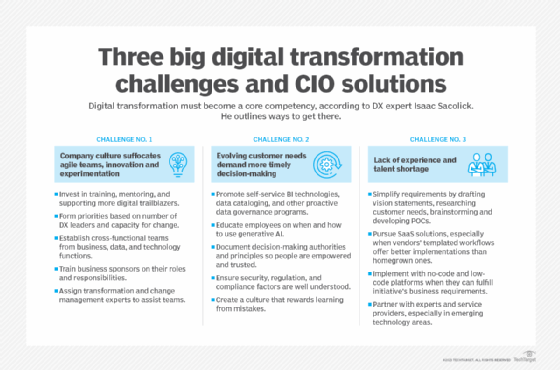Digital transformation challenges and 14 ways to solve them (original) (raw)
Heading into 2024, CIOs must make digital transformation a core competency. Bestselling author Isaac Sacolick names the primary challenges organizations face and how to solve them.
CIOs like to say "digital transformation is a journey," but after leading digital transformation programs for over a decade, I believe digital transformation must be a core organizational competency. Here's why.
Strategic, customer, and technical opportunities evolve every two to three years, requiring leaders to evaluate business strategy and realign priorities. Between 2017 and 2019, the primary driver of digital transformation was growth. From 2020 to 2022, the pandemic and shift to hybrid work significantly sped up the pace of digital transformation. In 2023, we saw the beginnings of generative AI-driven transformation. Progressive leaders overseeing digital transformation initiatives -- or what I call digital trailblazers -- must be prepared to pivot their programs and race toward these new opportunities while reducing operational risks -- or risk transformation failure.
Elevating digital transformation efforts into a core competency, however, is a major business objective and requires a strong commitment from the top ranks. It entails educating leaders, employees, and partners on how to fully engage with and improve a digital operating model. Practices associated with digital transformation, including design thinking, agile program management, DevOps, continuous improvement, digital innovation, automation, and data-driven organizational practices, can no longer be isolated to a few teams and programs -- they must be central to how the organization operates.
What makes creating digital transformation competencies a significant challenge? Below are three challenges digital transformation trailblazers will likely encounter. I discuss the issues that have to be dealt with and provide pointers on how to solve them.

Making digital transformation a core competency is imperative. Here are three challenges organizations typically face and pointers on how to solve them.
Company culture suffocates agile teams, innovation and experimentation
CEOs and CIOs often host town hall meetings to announce the updated business strategy, digital transformation priorities, and where they are channeling key investments. Hopefully, the announcement invigorates the organization's go-getters, innovators, experimenters, risk-takers, and others who embrace new responsibilities in transformation programs.
However, two cultural challenges typically emerge that will require special attention from IT leadership.
Critical mass . First, CIOs need a wide, diverse group of people leading and participating in digital transformation initiatives. If only 10% of digital transformation go-getters staff these new initiatives, it will take too long to develop customer-facing innovations, modernize legacy workflows, or enable new AI capabilities. CIOs will need programs to mentor digital trailblazers and align the organization on transformation business drivers.
Managing naysayers. Second, the go-getters will face many technology hurdles, but even more challenging than the technology is managing the different employee reactions to transformation objectives, including winning over demanding stakeholders, responding to employee pushback, or resolving issues escalated by detractors. For example, some will try tying agile teams to fixed duration and scoped deliverables but do not acknowledge how learning, experimentation, and feedback-driven processes are crucial to aligning transformation programs with customer needs.
5 ways CIOs can address these cultural challenges
- Invest in training, mentoring, and supporting more digital trailblazers while acknowledging the risk these leaders take on when leading digital transformation initiatives.
- Communicate a reasonable number of priorities given the number of digital transformation leaders and the rate of change the organization can absorb.
- Establish program charters that cut across organizational structures because transformation programs are not IT projects. They require cross-functional teams from business, data, and technology functions.
- Train business sponsors on their roles and responsibilities in transformation programs and being stakeholders working with agile teams, focusing on the iterative and feedback-driven approaches digital transformations require.
- Assign transformation and change management experts to assist teams with sending frequent communications, addressing people's concerns, and managing the most vocal detractors.
Evolving customer needs require smarter and faster decision-making
A second major digital transformation challenge is creating the environment, governance, data access, and tools to enable more people in the organization to make smart and faster decisions. Command and control organizations holding on to top-down decision-making practices struggle in transformation programs, especially in industries facing disruptors or business model evolutions.
This challenge magnifies as businesses must evolve their products and services to meet rapidly changing customer needs. The following are some examples of industries under pressure to digitalize their products and services:
- Healthcare . Patients want digitally-enabled hospitals with reduced wait times and more personalized treatment options.
- Government . Citizens demand more efficient, transparent, and responsive digital services that improve quality of life.
- Construction. CFOs want daily reports of work in progress and more accurate project profitability analyses.
- Manufacturing. Factory floors must be outfitted with IoT sensors, real-time data processing, and predictive data analytics to reduce errors and improve throughput.
Healthcare, government, construction, and manufacturing are generally regarded as technology-lagging industries. The ability to process data and enable faster decision-making is even more critical in retail, financial services, and technology industries, where products are expected to be personalized and have embedded AI capabilities.
5 ways CIOs enable a more data-driven organization
- Promote self-service BI technologies, data cataloging, and other proactive data governance programs so that more employees can access data to support their responsibilities.
- Educate employees on when and how to use generative AI to boost creativity and scale experiments, especially when learning about customer needs.
- Document decision-making authorities and principles so people are empowered and trusted to make informed decisions without escalating everything up the organizational chain.
- Ensure security, regulation, and compliance factors are well understood so people use data responsively.
- Create a culture that rewards learning from mistakes and failures and avoids blaming people when making data-driven, prudent, and informed decisions.
Lack of experience and talent shortages are execution bottlenecks
CIOs need digital trailblazers to lead initiatives, but that's insufficient to drive transformation as a core competency. They also require talent with a breadth of skills to plan, deliver, and evolve digital capabilities. Whether it's cloud architects, data scientists, or CISSP security engineers, CIOs are competing for the talent to staff their breadth of programs.
CIOs must attract top talent with multiple recruiting tactics and invest significant effort to retain high performers. Driving culture change, supporting hybrid work, and promoting lifelong learning are ways top CIOs demonstrate to prospective and current employees that they care about people and will invest in them.
But CIOs need more options beyond talent management, especially when there's increasing demand for more transformation initiatives and increasing risks if departments pursue shadow IT options.
Digital trailblazers drive simplification in problems, solutions, and methodologies. By keeping things simple (the KISS principle), there's a greater likelihood that more people can pursue solutions without the need for the most advanced technology skills.
4 ways CIOs can address the talent shortage
- Simplify requirements by drafting vision statements, dedicating time to research customer needs, scheduling time to brainstorm solutions, and developing simple proof of concepts.
- Pursue more configurable SaaS solutions, especially when vendors' templated workflows offer better implementations than homegrown ones.
- Implement with no-code and low-code platforms when they can fulfill most of the initiative's business requirements.
- Partner with experts and service providers, especially in emerging technology areas where the organization doesn't have skills or best practices.
The need to transform organizations will evolve as markets become more competitive, customer needs change, and technology drives new opportunities. The question for CIOs is how they will lead digital transformation as a core competency and address the common challenges facing them.
Isaac Sacolick is President of StarCIO, a technology leadership company that guides organizations on mentoring digital trailblazers and building digital transformation core competencies. He is the author of 'Digital Trailblazer' and the Amazon bestseller 'Driving Digital' and speaks about agile planning, DevOps, data science, product management, and other digital transformation best practices. Sacolick is a recognized top social CIO and a digital transformation influencer, with over 900 articles published on his blog Social, Agile, and Transformation, and other sites. You can find him sharing new insights on the Driving Digital Standup or during his weekly Coffee with Digital Trailblazers.
 9 must-read digital transformation books in 2025
9 must-read digital transformation books in 2025  By: Gabriella Frick
By: Gabriella Frick  bimodal IT (bimodal information technology)
bimodal IT (bimodal information technology)  By: Linda Tucci
By: Linda Tucci  10 online digital transformation certifications and courses
10 online digital transformation certifications and courses  12 digital transformation tips and best practices
12 digital transformation tips and best practices  By: John Moore
By: John Moore